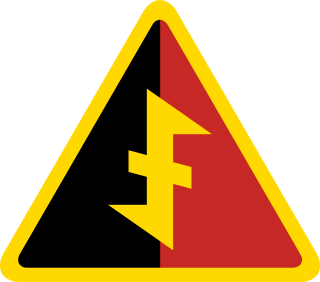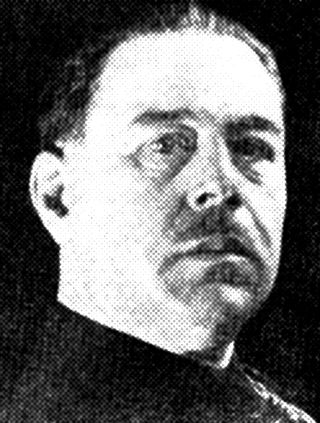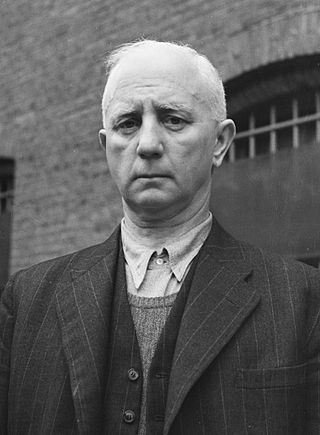
The National Socialist Movement in the Netherlands was a Dutch fascist and later Nazi political organisation that eventually became a political party. As a parliamentary party participating in legislative elections, the NSB had some success during the 1930s. Under German occupation, it remained the only legal party in the Netherlands during most of the Second World War.

The Rex Popular Front, or simply Rex, was a far-right Catholic authoritarian and corporatist political party active in Belgium from 1935 until 1945. The party was founded by a journalist, Léon Degrelle, It advocated Belgian unitarism and royalism. Initially, the party ran in both Flanders and Wallonia, but it never achieved much success outside Wallonia and Brussels. Its name was derived from the Roman Catholic journal and publishing company Christus Rex.

Anton Adriaan Mussert was a Dutch politician who co-founded the National Socialist Movement in the Netherlands (NSB) in 1931 and served as its leader until the party was banned in 1945. As such, he was the most prominent Dutch leader of the National Socialism movement before and during World War II. Mussert collaborated with the German occupation government, but was granted little actual power and held the nominal title of Leider van het Nederlandsche Volk from 1942 onwards. In May 1945, as the war came to an end in Europe, Mussert was captured and arrested by Allied forces. He was charged and convicted of treason, and was executed in 1946.

Cornelis "Kees" van Geelkerken was a Dutch fascist political leader and Nazi collaborator.

The Biographical Dictionary of the Extreme Right Since 1890 is a reference book by Philip Rees, on leading people in the various far right movements since 1890. It contains entries for what the author regards as "the 500 major figures on the radical right, extreme right, and revolutionary right from 1890 to the present" . It was published, as a 418-page hardcover, in New York by Simon & Schuster in 1990 (ISBN 0-13-089301-3).
Fascist symbolism is the use of certain images and symbols which are designed to represent aspects of fascism. These include national symbols of historical importance, goals, and political policies. The best-known are the fasces, which was the original symbol of fascism, and the swastika of Nazism.
A number of political movements have involved their members wearing uniforms, typically as a way of showing their identity in marches and demonstrations. The wearing of political uniforms has tended to be associated with radical political beliefs, typically at the far-right or far-left of politics, and can be used to imply a paramilitary type of organization.

The National Socialist Dutch Workers Party or NSNAP was a minor Dutch Nazi party founded in 1931 and led by Ernst Herman van Rappard. Seeking to copy the fascism of others, notably Adolf Hitler, the group failed to achieve success and was accused by rivals such as the National Socialist Movement in the Netherlands (NSB) and the General Dutch Fascist League of being too moderate for a fascist movement.
The National European Social Movement was a Dutch neo-Nazi party, founded in 1953 as the political arm of the Stichting Oud Politieke Delinquenten, and disbanded by a ruling of the Dutch Supreme Court in 1955.

Coenraad Alfred Augustus Haighton was a millionaire businessman and the leader of the Netherlands' first fascist movement.

Arnoldus Jozephus Meijer was a Dutch fascist politician.

The Reichskommissariat Niederlande was the civilian occupation regime set up by Germany in the German-occupied Netherlands during World War II. Its full title was the Reich Commissariat for the Occupied Dutch Territories. The administration was headed by Arthur Seyss-Inquart, formerly the last chancellor of Austria before initiating its annexation by Germany.

Paul Hoornaert was a Belgian far right political activist. Although a pioneer of fascism in the country he was an opponent of German Nazism and, after joining the Belgian Resistance during the German occupation, died in Nazi custody.

Marius Hugh Louis Wilhelm Blokzijl or Max Blokzijl was a Dutch singer and journalist. After the German occupation of the Netherlands Blokzijl was sentenced to death and executed for his collaboration with Nazi Germany.

Robert van Genechten was a Belgian-born Dutch politician and writer and a leading collaborator during the German occupation of the Netherlands.
Josephus Alphonsus Marie François was a Belgian Flemish far right politician and Nazi collaborator.
Jan Aksel Wolthuis, a lawyer by training, was a Dutch Nazi who collaborated with the German occupiers during World War II and after the war was active in far-right politics.

The Weerbaarheidsafdeling was the paramilitary arm of the National Socialist Movement in the Netherlands (NSB), the fascist political party that collaborated with the German occupiers of the Netherlands during World War II. The organization, roughly equivalent to the German SA, was founded in 1932 by Anton Mussert, co-founder of the NSB in 1931 and its leader until the end of the war. Members wore and marched in black uniforms and were thus called "blackshirts". In 1933 the Dutch government banned the wearing of uniforms, and the WA was disbanded in 1935 in order to forestall the Dutch government's banning it. In 1940, after the German invasion, the WA became openly active again, and more ruthless than before. They specialized in violent attacks, particularly on the Dutch Jewish population.
The Netherlands Union was a short-lived political movement active in the German-occupied Netherlands in World War II. In its brief period of activity between July 1940 and May 1941, up to 800,000 Dutch people became members, which was about a tenth of the population at the time. It represented the largest political movement in the history of the Netherlands.














